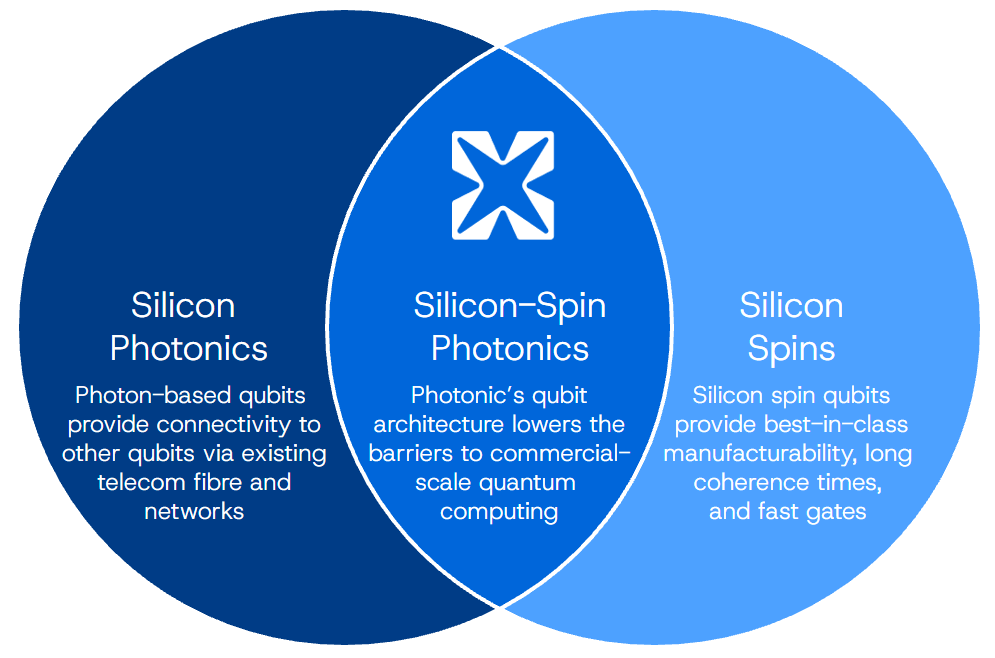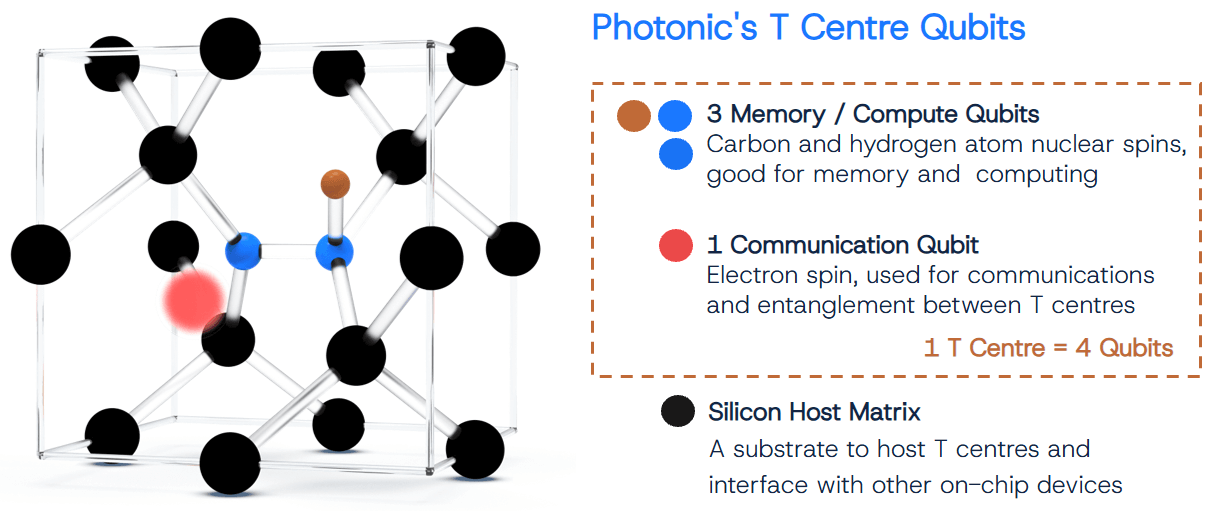As the field of quantum computing expands, so do the qubit modalities behind it. Which one ultimately dominates will depend on a combination of performance, capabilities, ease of implementation, and cost of ownership. While many of the early approaches have demonstrated small-scale logical qubits, they face technical barriers getting to high qubit counts, and in achieving the efficient connections between modules needed to deliver fault tolerant quantum computing at scale. The qubits behind Photonic’s distinct Entanglement First™ architecture—called T centres—are different. They were chosen to deliver quantum computing and quantum networking at commercial scale, by design.

T centres are a powerful qubit modality based on color centres in silicon. T centres are unique in matching many of the best characteristics of other modalities (coherence times, gate speed, photonic interconnects, etc.), with additional advantages of their own. They are also highly practical—T centres are fabricated in a silicon matrix, making it much easier to implement the vast array of control and support systems needed to stabilize and operate a qubit. Most importantly, T centres have a built-in ability to connect with one another using light, which is the key to efficient error-correction codes and networking between quantum processors.
What is the structure of a T centre?
A T centre is a specific type of silicon colour centre—an atomic-level implanted structure manufactured in a silicon substrate. They exhibit special optical and spin properties that make them work well as qubits, including the ability to absorb and emit light at specific wavelengths. Colour centres in silicon are especially useful, as they interface seamlessly with standard photonic integrated circuit technology.
Each T centre is composed of a hydrogen atom and two carbon atoms with an associated electron, all squeezed into the place a one silicon atom would normally occupy. This compact structure gives a T centre a powerful range of qubit capabilities, all housed in a single, easily addressable silicon host.

Due to the T centre’s special structure, the carbon and hydrogen atoms can each function as nuclear spin qubits, with long coherence times ideal for memory and long-term quantum information storage (a benefit associated with diamond NV centres and other semiconductor spin qubits).
Another key part of this structure is the electron – it has its own spin which can be manipulated and coupled to other qubits on fast timescales (a property for which quantum dot qubits are known). The electron in a silicon T centre has the added advantage that it absorbs and emits light at a low-loss telecom wavelength, making it perfect for communicating directly with other T centres over fibre without the additional conversion steps required by some other modalities. For this reason, they are often referred to as photonically-linked silicon spin qubits.
The surrounding silicon also plays a key role, making it easier to stabilize, control, and connect the T centres. Silicon is the most widely used material in semiconductor manufacturing, so the techniques needed to control qubits like microwaves and lasers are already well established and mass-producible at high densities. T centres are also naturally isolated and stabilized by their silicon host, which makes them less susceptible to thermal interference. As a result, they require less cooling than many other qubits, simplifying system design and reducing cost.
What makes a T centre special?
Taken together, a T centre has an ideal set of attributes for quantum computing: a total of four spins that can be used as qubits for computation and memory, efficient communication with other qubits at telecom wavelengths over standard fibre networks, control and connection via existing semiconductor PIC technology, high qubit densities in a single chip, and relatively low cooling requirements.

These properties, in turn, allow easier and more robust entanglement between qubits—key to quantum computing—and facilitate modular, distributed quantum computing, making it easier to scale up and scale out to commercial utility.
When compared to other qubit modalities, T centres offer a strong hybrid of the best qualities, and benefit additionally from the manufacturability of silicon. As a result, considerable research is being done on T centres and similar colour centres globally, and new startups are emerging in industry.
Photonic Inc: Leading distributed quantum computing with T centres
Photonic Inc. was founded to leverage the unique properties of T centres for quantum computing and intends to be the first to create a distributed quantum computing platform at commercial scale.
The company is scaling up and scaling out each aspect needed to create a full-stack quantum computer – qubit, control, coding, and connectivity – taking a highly practical approach to delivering on commercial-scale quantum computing. One that is more manufacturable, with less implementation hurdles (engineering vs science), and lower final cost of ownership. One that can be scaled and networked much easier than other qubit modalities. At Photonic, we believe T centres will enable the quantum networks of the future.
To learn more about how T centres enable commercial-scale distributed quantum computing, read our white paper: What could networks of quantum supercomputers look like?
The Mission to Design the Ideal Qubit
There are several types of silicon colour centres, and many more are being actively explored for quantum computing potential. Photonic’s founders, Dr. Stephanie Simmons and Dr. Michael Thewalt, searched extensively for a colour centre with the right qubit properties and entanglement capabilities needed to enable quantum networking.
Explore the full vision: What could networks of quantum supercomputers look like?